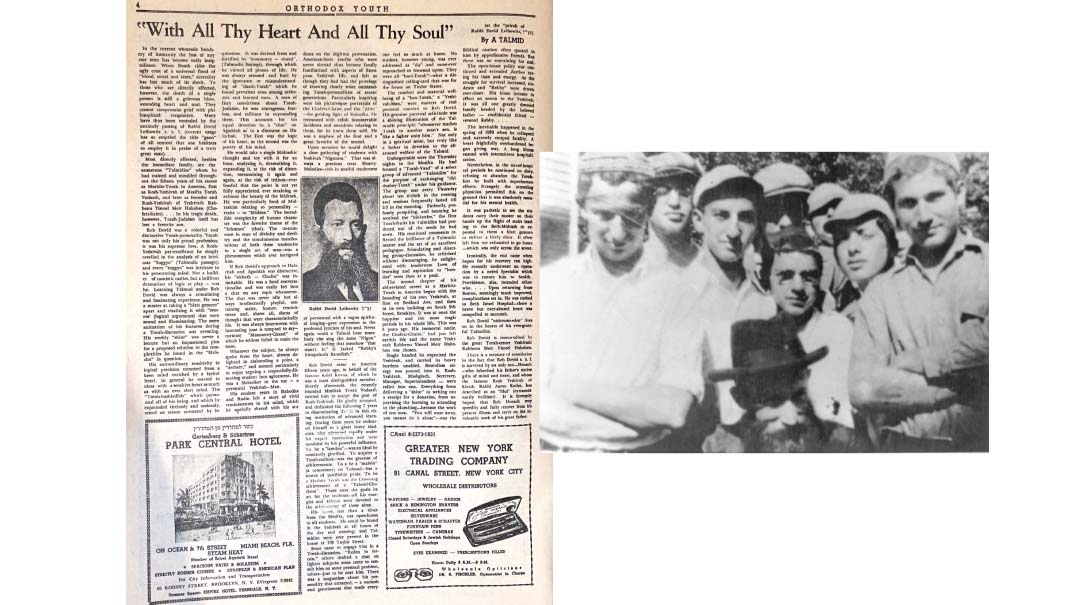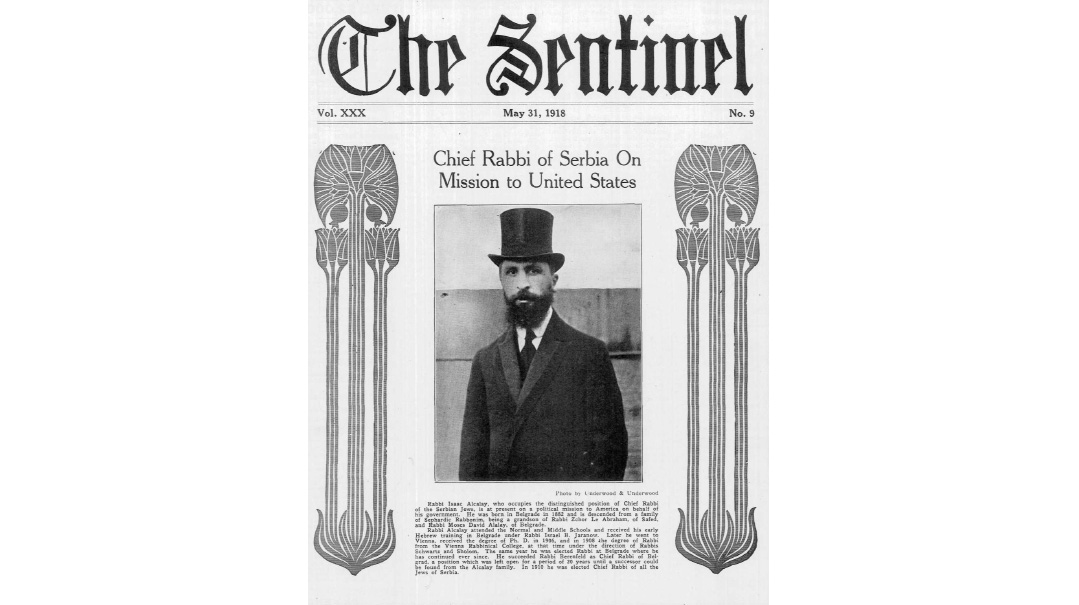Remembering Reb Dovid
| November 16, 2021He did not believe that American yeshivah youth were any less yirei Shomayim than their Eastern European counterparts

Title: Remembering Reb Dovid
Location: New York
Document: Orthodox Youth
Time: December 1941
This Friday, 15 Kislev marks the 80th Yahrtzeit of Rav Dovid Leibowitz
Upon Rav Dovid’s passing, a moving tribute appeared in Orthodox Youth, the mouthpiece of Zeirei Agudath Yisrael. Though the byline simply read “A talmid,” it was well known that the writer was Rav Avrohom Yaakov Pam
December 7, 1941, “a date which will live in infamy,” was to be forever associated with the Japanese attack on Pearl Harbor and the subsequent entry of the United States into World War II.
But for a large group of mourners converging on Mount Judah cemetery in Queens for the burial of Rav Dovid Leibowitz, it was to be a date that left a gaping spiritual void for America’s nascent Torah community. The untimely passing three days prior of this pioneering rosh yeshivah, still in his early fifties, was a setback to his efforts of transplanting the Torah of Slabodka and Radin to America.
Rav Dovid was the grandson of Rav Aharon HaKohein, the elder half-brother of the Chofetz Chaim. As a result, following his studies in the Lomza Yeshivah, young “Dovid Varshaver” went to study by his great uncle in Radin. He then proceeded to Slabodka, where he emerged as one of the closest students of the Alter of Slabodka, Rav Nosson Tzvi Finkel. Rav Leizer Yudel Finkel related that his father chose the young and unmarried Rav Dovid to lead the davening in Slabodka for Yamim Noraim, a testament to the great spiritual heights that his young talmid had achieved.
In 1915 Rav Dovid married Leah Shereshevsky, daughter of Rav Chanoch Henoch Shereshevsky, rabbi of Salechnik and Beinukon. When his father-in-law passed away shortly afterwards, Rav Dovid succeeded him in the rabbinate. In 1921 he returned to his alma mater to study in the renowned Kovno Kollel, where he spent the next five years learning under Rav Isaac Sher and alongside Torah giants such as Rav Yaakov Kamenetsky, Rav Yaakov Moshe Lessin, and Rav Shmuel Leib Svei.
Along with a spot in this coveted kollel came a commitment to fundraise following five years of study. When he arrived in America in 1927, the newly founded Mesivta Torah Vodaath was searching for a rosh yeshivah. After Rav Shraga Feivel was unsuccessful in luring Rav Menachem Ziemba from Warsaw, Rav Dovid was recommended for the post. Unsure whether to accept the position, he wrote to the Chofetz Chaim, whose advice was unequivocal: “Dovid, du kenst boyen Torah in America [you can build Torah in America].”
By 1929 Rav Dovid was firmly ensconced in the US, and he sent for his wife and son (and later successor) Rav Henoch to join him. At Torah Vodaath, he set forth to educate future Torah leaders. Among those were Rav Avrohom Pam, Rav Gedaliah Schorr, Rav Dovid Bender, his son Rav Henoch Leibowitz, and Rav Nesanel Quinn. A half century later, Rav Pam was invited to share his reminiscences at a 50th yahrtzeit gathering at Yeshivah Chofetz Chaim (RSA) in Queens.
Reflecting on the close relationship enjoyed between rebbi and talmid, Rav Pam related, “We recall the personal warmth and kavod for each talmid. I can’t get over it when I think about it. I was less than 15 years old when I entered his shiur. And right away he called me ihr [the more respectful plural you]. Nisht du, chas v’shalom. Naturally that makes you feel like you’re somebody.”
Rav Pam continued by emphasizing the pioneering atmosphere in the yeshivah at the time, a veritable isolated island of Torah. “And I must say we were very lonely.… But the Rebbi connected us with the mosdos haTorah of Europe, constantly talking to us about Slabodka, about Radin, about the Chofetz Chaim. He made us feel that we were part of a great olam haTorah. Unfortunately it’s not here yet, we first have to establish it here.... Through these stories he brought us into the world of Torah in Europe. And we saw what we were a part of.”
This gave them the conviction to be able to disregard the many distractions of the American street, while personally serving as a connection across time and space.
In 1933 Rav Dovid established his own institution on South 9th Street in Williamsburg, which he named for his recently deceased great-uncle the Chofetz Chaim. “Singlehandedly he organized the yeshivah,” wrote Rav Pam (who remained in Torah Vodaath), “and carried its burdens unaided ... rosh yeshivah, mashgiach, secretary, manager, superintendent were rolled into one. Everything, from delivering a shiur to writing out a receipt for a donation, from supervising the learning to attending to the plumbing, became the work of one man....”
As a premier student of the Alter of Slabodka and his mussar philosophy, Rav Dovid endeavored to impart its lessons to his American talmidim in this novel institution. This was especially apparent in his unique approach to what can be colloquially referred to with the oblique term frumkeit. In consonance with his Slabodka upbringing, Rav Leibowitz was diametrically opposed to external expressions of frumkeit that weren’t in harmony with internal spiritual development.
In an article written by Reb Yitzchok Brandriss that appeared in the Jewish Observer on occasion of Rav Dovid’s 50th yahrtzeit, this point is illustrated:
His son Rav Henoch once came home with a new black suit. Reb Dovid sent him back to the clothing store to return it. That had not been the dress in Slobodka. In Reb Dovid’s estimation, his son was improperly investing the wearing of a black suit with religious meaning, and he wouldn’t permit it. At the same time, he insisted that talmidim from chassidic homes, whose long-enshrined traditions stressed a certain mode of dress as part of their religious code, must abide by those traditions. The question was only how one relates internally to his outer actions.
Someone once declared to him, “S’felt yiras Shomayim heint — fear of Heaven is sorely lacking these days.”
Reb Dovid replied, “Nein. S’felt Torah! — No. What is lacking is Torah.”
He did not believe that American yeshivah youth were any less yirei Shomayim than their Eastern European counterparts. What they needed, however was exposure to a pure, deep and true understanding of Torah and its mussar. He believed they would respond to it. And thus fortified, they would need no artificial support.
Molding the Mishnah Berurah
Rav Dovid was privileged to study with the Chofetz Chaim for two years, in memorable sessions that often lasted as long as 12 hours. They learned Hilchos Succah, with their study serving as the basis for the Mishnah Berurah on these halachos.
Torah Is Here To Stay
When Rav Yaakov Kamenetsky, his colleague from Slabodka, arrived on American shores, he inquired of his friend Rav Dovid regarding a position at Torah Vodaath. While there were no openings at the time, he emboldened Rav Yaakov, telling him that, “While there is no money here in America, if you want ruchniyus, you can grab it in fistfuls!” Rav Yaakov dispatched his oldest son Binyamin to study under Rav Dovid’s tutelage. Rav Yaakov told him that had he been able to afford it back in Lithuania, he would have sent him from Europe to the United States to study under Rav Dovid.
Shirts Starched in Slabodka
Rav Dovid’s talmidim recalled how even as the financial struggles of the yeshivah left him destitute, he was always seen with a perfectly starched shirt, a tribute to his Slabodka roots and a reminder of what he had set out to build.
Raising Rav Henoch
Rav Henoch Leibowitz, who was still a child in Slabodka, remembered how he was urged by people close to him not to go to a spiritually desolate America. After their arrival, Rav Yitzchok Hutner told Rav David in jest, “You should hide your son in a room here, so that people will think he went to Europe. He doesn’t need to learn in Europe, he’ll do just as well with you.” Ultimately it was Rav Henoch who would personify the values he imbibed in his father’s home, and lead the yeshivah that he inherited while in his twenties to become a shining example of Torah and mussar that continues to light up the world.
(Originally featured in Mishpacha, Issue 886)
Oops! We could not locate your form.






